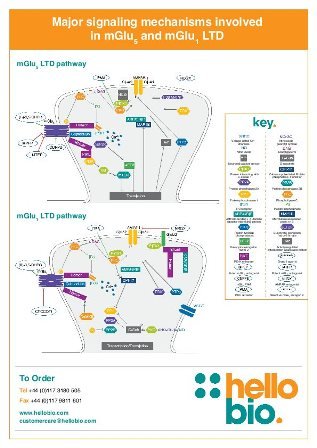Major signaling mechanisms involved in mGlu5 and mGlu1 LTD

mGluR-long term depression (LTD) is thought to be involved in many processes such as goal directed learning and in pathological conditions such as Alzheimer’s disease, Parkinson’s disease and drug addiction. This pathway poster summarises some of the many signaling mechanisms involved in this process. Download pdf
mGlu5 LTD
Stimulation of group I mGlu receptors (mGlu1 and mGlu5), leads to the activation of the PLC pathway which releases Ca2+ from intracellular stores and activates PKC. LTD in the hippocampus is induced primarily through mGlu5 activation and AMPAR mediation.
PICK1 forms a complex with NCS-1 which is thought to act as a Ca2+ sensor for LTD. PICK1 may also bind PKC-α to phosphorylate the GluA2 subunit of the AMPAR and dissociate ABP-GRIP.This may lead to removal of AMPARs from synapses.
Many other enzymes, pathways and proteins such as MAP1B, PTPs, ARC, ERK and P38 MAPK are also required or involved in mGlu5 LTD although not all downstream effectors are yet fully understood.
The PI3K/AKT/mTOR pathway is thought to be involved in the control of translation and eEF2K/eEF2 may act as a regulator of translation.
mGlu1 LTD
mGlu1 is expressed primarily in the cerebellum and mGlu1 activation at synapses between cerebellar parallel fiber and Purkinje cells induces LTD. This occurs when both climbing and parallel fibers are activated.
Many similar proteins and cascades are involved in both mGlu1 and mGlu5 LTD, such as activation of the PLC pathway leading to subsequent PKC activation and Ca2+ release. mGlu1 LTD is dependent on intracellular Ca2+ increase and in a secondary pathway initiated by climbing fiber activation, Ca2+ enters the synapse through VGCCs to increase intracellular Ca2+.
Many other proteins and pathways are also involved in mGlu1 LTD such as the δ2 glutamate receptor (GluD2) which plays an important role supporting LTD induction. The NO-cGMP cascade is also involved and mGlu1 LTD is thought to be NO dependent in which NO acts as a crucial mediator. Other enzymes such as serine/threonine phosphatases e.g. PP1, PP2A and PP2B are involved in LTD.
References
Luescher, C & Huber KM (2010) Group 1 mGluR-dependent synaptic long-term depression: mechanisms and implications for circuitry and disease. Neuron. 65:445-59 Gladding CM et al (2009) Metabotropic glutamate receptor-mediated long-term depression: molecular mechanisms. Pharmacol Rev. 61:395-412 Collingridge, GL et al (2010) Long-term depression in the CNS. Nat Rev Neurosci. 11:459-73 Kakegawa, W et al (2007) The delta2 ‘ionotropic’ glutamate receptor functions as a non-ionotropic receptor to control cerebellar synaptic plasticity. J Physiol. 584:89-96 Ogasawara, H et al (2007) Nitric oxide regulates input specifi city of long-term depression and context dependence of cerebellar learning. PLoS Comput Biol. 3:e179 Belmeguenai, A et al (2005) A role for protein phosphatases 1, 2A, and 2B in cerebellar long-term potentiation. J Neurosci. 25:10768-72
Tools for studying synaptic plasticity
Browse our range of glutamate receptor agonists, antagonists, PAMs and NAMs below:
| Metabotropic glutamate receptors | Ionotropic glutamate receptors | Transport |
Our glutamate receptor research tools are available at prices up to 50% less than other suppliers. Take a look at our price comparison tables to see for yourself.
Featured glutamate products
A selective and non-competitive mGlu5 receptor antagonist (Ki = 42 nM). Displays antidepressant, anxiolytic and neuroprotective properties. Available at high purity (>99%)...View full product details
Selective, competitive NMDA receptor antagonist. Binds at glutamate site. More active form of DL-AP5. Available at high purity (>99%)...View full product details







